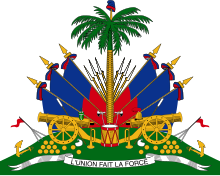| Armed Forces of Haiti | |
|---|---|
| Forces Armées d'Haïti (French) Fòs Lame d'Ayiti (Haitian Creole) | |
 Emblem of the Armed Forces of Haiti  Combat Patch of the Armed Forces of Haiti | |
 Coat of Arms of Haiti | |
| Founded | 18 May 1803[1] (Indigenous Army) |
| Current form | 17 November 2017 |
| Service branches | Haitian Navy |
| Headquarters | Grand Quartier Général Port-au-Prince, Haiti |
| Website | https://md.gouv.ht/ |
| Leadership | |
| Nominal Head | |
| Minister of Defense | |
| Commander-in-Chief of the Armed Forces | |
| Deputy Commander-in-Chief | |
| Chief of the General Staff | |
| Personnel | |
| Military age | 18–25 |
| Available for military service | 5,534,135, age 15–49 |
| Active personnel | 1500 – 2000 (2023) |
| Expenditure | |
| Budget | HTG 6.976 billion (2024) (USD $52.9 million)[2] |
| Percent of GDP | 0.2 |
| Industry | |
| Foreign suppliers | |
| Related articles | |
| History | Military history of Haiti Gang war in Haiti |
| Ranks | Military ranks of Haiti |
The Armed Forces of Haiti (French: Forces Armées d'Haïti, Haitian Creole: Fòs Lame d'Ayiti) are the military forces of the Republic of Haiti, is composed of the Haitian Army, the Haitian Navy, and the Haitian Aviation Corps. The Force has about 2000 active personnel as of 2023,[7] with the army and aviation corps being active, and navy personnel still in the works.
The Haitian military originated during the Haitian Revolution as the Indigenous Army (Armée Indigène) that fought for independence, which was formally declared on 1 January 1804.[1] Haiti became a militarized country over the next several decades to protect its independence from a possible return of French troops, and as a result the military dominated the government and administration,[8] with the emergence of a military elite that held the political and economic power in the country.[9] The military was reorganized in the 1880s, being divided between a small active army that underwent the reform, and a much larger reserve army consisting of the old forces. There was also a small navy.[10] Between 1804 and 1915, all except one of Haiti's 26 heads of state were military officers.[11]
The Indigenous Army was disbanded during the United States occupation of Haiti in 1915 and replaced by the American-trained and -led Gendarmerie (Gendarmerie d'Haïti). In 1934, it was renamed the Garde d'Haiti and returned to Haitian command, before being renamed the Army of Haiti in 1947.[12] Finally, it was changed to the Armed Forces of Haiti in 1958 during the rule of François Duvalier.[13] After years of military interference in politics, including dozens of military coups and attempted coups, Haiti disbanded its military in 1995.[14] The Haitian National Police was established that same year to take over security.[15]
On 17 November 2017, the armed forces were restored by President Jovenel Moise. The Army was reestablished in 2018. The President suspended the previous executive orders by then President Jean-Bertrand Aristide who suspended and disbanded the armed forces on 6 December 1995.
As of 2024, the number of active members is estimated in the range of 1500 to 2000.
- ^ a b Avril 1999, pp. 40–41.
- ^ Le Moniteur. "Décret établissant le budget général de la République d'Haïti, Exercice Fiscal 2024–2025" (PDF). p. 18,26,59,157–160.
- ^ "En fin de mission, l'ambassadeur de Taïwan en Haïti, Wen-Jiann KU satisfait de la coopération entre les deux pays".
- ^ "Demand to fire Haiti's foreign minister triggers standoff inside U.S.-backed transition". Miami Herald.
- ^ "« Haïti renforce ses partenariats avec les Émirats Arabes Unis et le Kenya », se réjouit le Premier ministre Conille".
- ^ "FADH: le ministre haïtien de la Défense cherche le support des pays de l'Amérique".
- ^ ICI.Radio-Canada.ca, Zone International- (17 March 2023). "Le premier ministre haïtien sollicite l'armée pour contrer la violence des gangs". Radio-Canada (in Canadian French). Retrieved 6 July 2024.
- ^ Avril 1999, p. 43.
- ^ Gerlus 1996, pp. 240–242.
- ^ Avril 1999, pp. 52–53.
- ^ Gerlus 1996, p. 250.
- ^ Avril 1999, p. 31.
- ^ Laguerre 1993, p. 107.
- ^ "Haiti a step closer to having army again". USA Today. Petite Riviere de l'Artibonite, Haiti. Associated Press. 16 September 2013. Retrieved 29 January 2014.
- ^ Metz 2001, pp. 477–479.